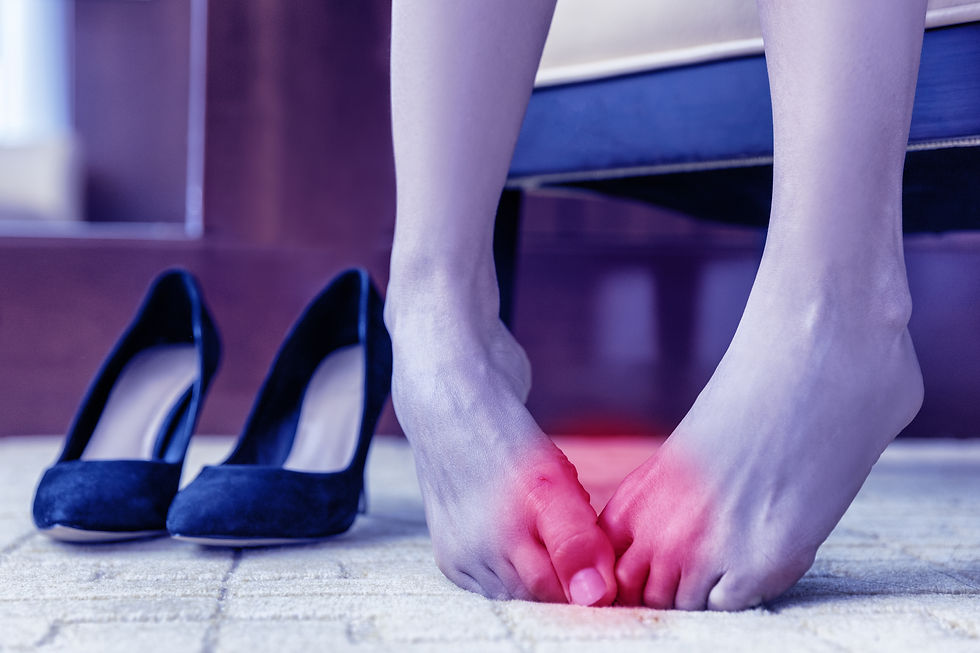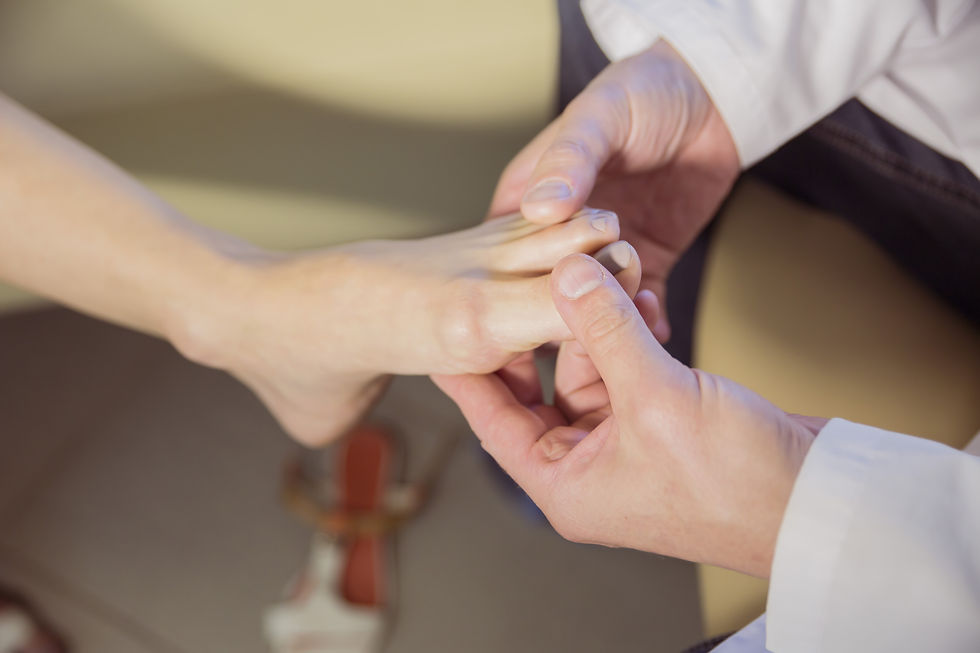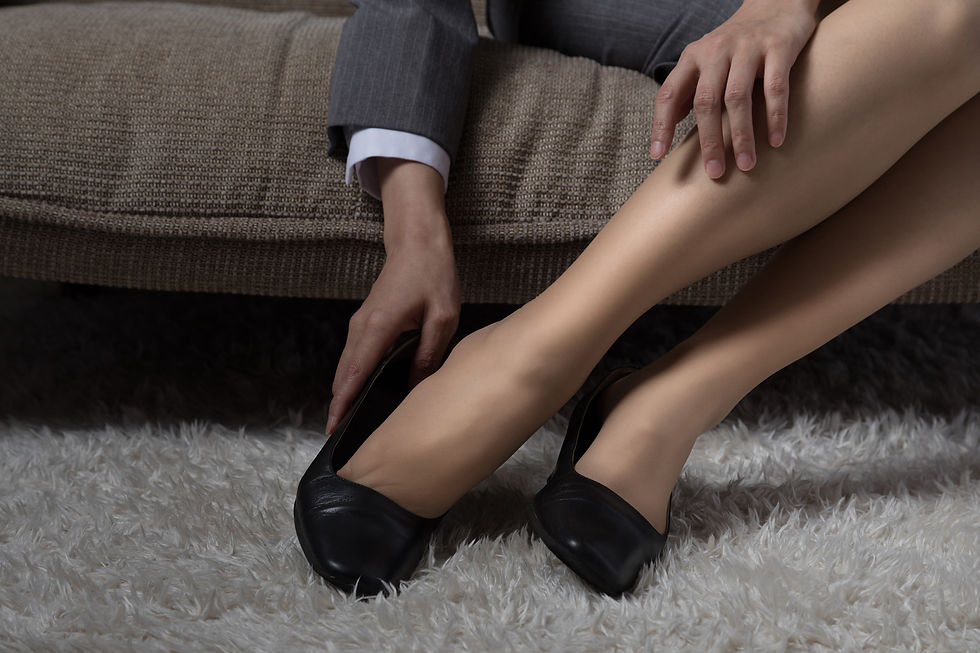
Ah, bunions. Imagine if you will, a freeloading guest. You don't expect their arrival. They soon wear out their welcome. After a while, you start wondering how they are still there.
Wait, did you even invite them? Did you do something to cause them to stay indefinitely? Is there any way to make their stay more bearable? Can't I make this person disappear?
Now imagine the guest is stuck to your foot!
That what it's like to have bunions. And much like the annoying guest, you don't want to ignore bunions. Their stay tends to get worse and lead to greater problems down the road.
Had enough of my analogy? Understood. Let's hone it in and take some time to talk about bunions.
WHAT IS A BUNION?

A bunion is a "bony bump at the base of the big toe". Bunions can be painful and downright bothersome. They can hamper your ability to enjoy your favorite activities, in a big way.
If you have pain from bunions, you definitely are not alone. Almost 3 million people per year suffer from bunions. Although that's little consolation, it is good to know that we treat this condition on a regular basis.
HOW DO BUNIONS FORM?
Bunions form as the big toe presses against its neighbor toe.
Factors that may cause bunions:
Shoes that are too tight or that do not fit well
Undue stress upon the foot
Arthritis in the foot
SURGERY FOR BUNIONS
While bunion pain is something you may be able to live with, you shouldn't ignore bunions. Why? They can get worse and continue to impede a healthy lifestyle.
Let's touch on some tips for easing bunion pain. You can:
Find shoes that offer a comfortable and supportive fit for your foot
Use orthotics to achieve a customized fit for your shoesIce the bunion often
Do exercises with your foot
Get surgery
Right now let's tackle the "get surgery" option. We'll go over some of the options for bunion surgery and outline what to expect. The goal is to get you informed on what bunion surgery entails.
REVIEW: WHAT ARE BUNIONS?
Bunions are a condition that develops when the bones of the big toe become misaligned. This is often due to wearing shoes that force the toe into an unnatural position.
The pressure on the joint of the big toe causes it to extend past the regular "profile" of the foot.
This can cause all kinds of pain. Not a good scene.
DO YOU NEED SURGERY FOR YOUR BUNION?

Bunions often grow in size over time. But surgery isn't always necessary. Here are some guidelines to consider before electing for surgery. The following factors will help you identify if you are a candidate.
If you do less activities due to foot pain from the bunion, consider surgery.
Chronic inflammation of the toe? Consider surgery.
Deformity of the toe that is causing the toes to overlap? Think about surgery.
Pain that doesn't stop even when you change to different shoes? Consider surgery.
Stiffness in the toe that won't go away? Talk to your doc about surgery.
WHAT SHOULD YOU KNOW BEFORE HAVING BUNION SURGERY?
We never recommend surgery without knowing your options. Remember, you'll get a lot more clarity when you talk to your surgeon. So if you think bunion surgery is right for you, schedule an appointment and let a pro talk you through it.
TENDON AND LIGAMENT REPAIR
Once in a while, we see a situation where the tissue about the big toe is looser on one side and tighter on the other. This results in the big toe "drifting" towards the smaller toes.
With ligament and tendon repair surgery, we correct his imbalance. Often times this happens in conjunction with an osteotomy to realign the bone.
OSTEOTOMY
With osteotomy, we straighten the bones and balance the joint. We do this by making incisions in the bone, realigning the bone, and fixing the break with pins and screws.
As a procedure, an Osteotomy is not specific to bunions. But it is one of our best options in dealing with the condition. As we mentioned, it's common to do an Osteotomy while also doing tendon/ligament repair.
EXOSTECTOMY
With an Exostectomy, we remove the bump on your toe joint. This procedure doesn't correct the cause of the problem, though. That's why an exostectomy is often done in conjunction with the Osteotomy/tendon and ligament repair.
ARTHRODESIS
If the bunion is severe or if the patient is dealing with major arthritis, artrhodesis becomes an option.
Here's what we do in an Arthrodesis:
We remove the joint surfaces that are causing the arthritis.
We insert plates or screws to hold the bone together.
We wait for the bone to heal.
This usually isn't our "first choice" surgery, but we do use an arthrodesis for people who are have bunions that are severe or who have major arthritis.
RESECTION ARTHROPLASTY
Removing the damaged part of the joint is the goal of this surgery. In this procedure, your doctor removes the damaged portion of the joint.
This increases the space between the bones and creates a flexible "scar" joint. Because this procedure can change the push-off power of the big toe, it is not often recommended.
BUNION SURGERY - WHAT COMES NEXT?

PHYSICAL THERAPY AND EXERCISE
Luckily for us (and for you), we have access to some fantastic physical therapists. After your surgery, they can take you through a bevy of exercises to help you recover.
This is a key part of your recovery, so go into it with a good attitude and a can-do spirit.
SHOES ARE KEY
If you've had bunion surgery, it's time to retire the high heels. While recovering from your bunion surgery, pay close attention to your footwear choices. Wear sneakers/leather shoes that protect and support without upsetting the bunion correction. Sorry ladies, no high heels!
In fact, you should avoid "high-fashion, high-impact" shoes in the future. We don't want to see you in here for bunion surgery on a regular basis, ok?
WILL YOUR BUNION SURGERY FIX THE PROBLEM?
We wouldn't recommend surgery if it we weren't sure of a high rate of favorable outcomes. If everything goes well, the result should be a dramatic decrease in pain.
Your toe will be in a more natural position, and you'll be able to do some of the activities you love on a more regular basis. And that's what we like to see after surgery.
HOW TO EASE PAIN FROM BUNIONS - WITHOUT SURGERY

We covered what a bunion is. But chances are you're here because you're wondering how to ease bunion pain from bunions. You might not need surgery to deal with your bunions. Try these techniques to ease the pain of bunions:
1. TRY DIFFERENT SHOES
It bears mentioning again. There is a reason that most cases of bunions (some reports say up to 90%) effect women. One reason bunions effect women more often is that they can be caused by wearing shoes that are too narrow. The exaggerated, pointed toes of high heeled shoes are a prime culprit.
So ladies, avoid the high heels if you want to ease bunion pain. Find shoes with a more forgiving toe box. Try to avoid shoes with seams around the toe area. And if you don't know which shoe to pick, visit a shoe store that specializes in custom fits. Your feet will thank you.
2. USE ORTHOTICS
What's an orthotic? It's an insert that goes inside your shoe. Often molded to your foot specifically, an orthotic can work wonders for bunions.
By adjusting the mechanics of your feet, orthotics may slow down bunion progression or alleviate the condition completely.
At the least, orthotics can ease bunion pain by correcting excessive pronation of the feet. The same pronation which may have caused the bunion in the first place.
3. ICE IT
Much like a loyal pet you can always depend on, icing is a consistent solution to relieving swelling. Icing is not a long term solution, but it can be invaluable for the temporary relief of pain.
In this regard, icing bunions is no different. Icing will relieve the swelling after a long day of walking or standing. That's why it's such a reliable way to ease bunion pain. (Don't apply the ice directly to the bunion, use a pack or wrap.)
4. EXERCISE THE FOOT
Although exercise can't make the condition disappear, they can ease bunion pain. There are special exercises to build strength in the muscles of the foot and toes. Here are a couple:
Use your toes to pick up something small such as a pebbleAlternate curling, then pointing your toes Pull your big toe into place for a few seconds. (Be gentle!)
Here's an article with more exercises to ease bunion pain that may be helpful.
Remember, we're concerned with helping you preserve an active lifestyle.
So what if none of these other methods help to ease bunion pain? That's the time to reach out to an experienced surgeon to go over your options. He'll have an idea if surgery is right for you, based on the severity of your specific case.
Good luck and stay healthy!
(Note: Dr. Elton also published the article on his website wwwdrelton.com. Visit his blog for more tips on foot and ankle injuries, conditions, and procedures.)
